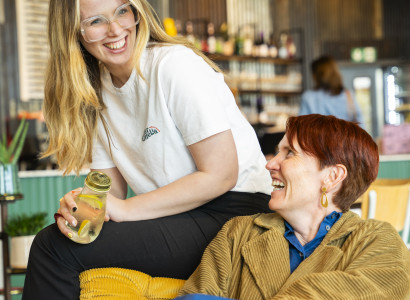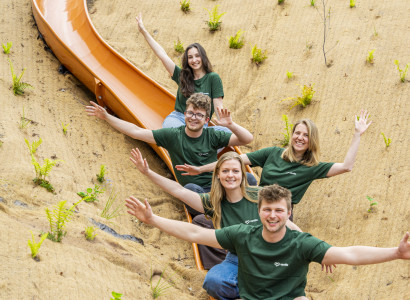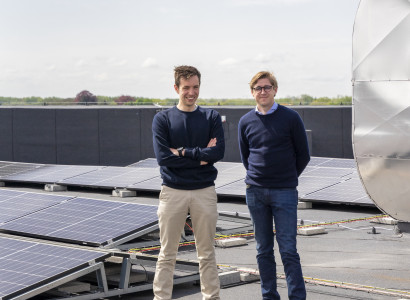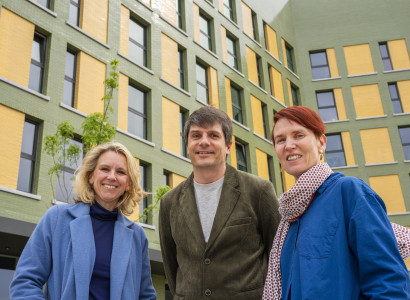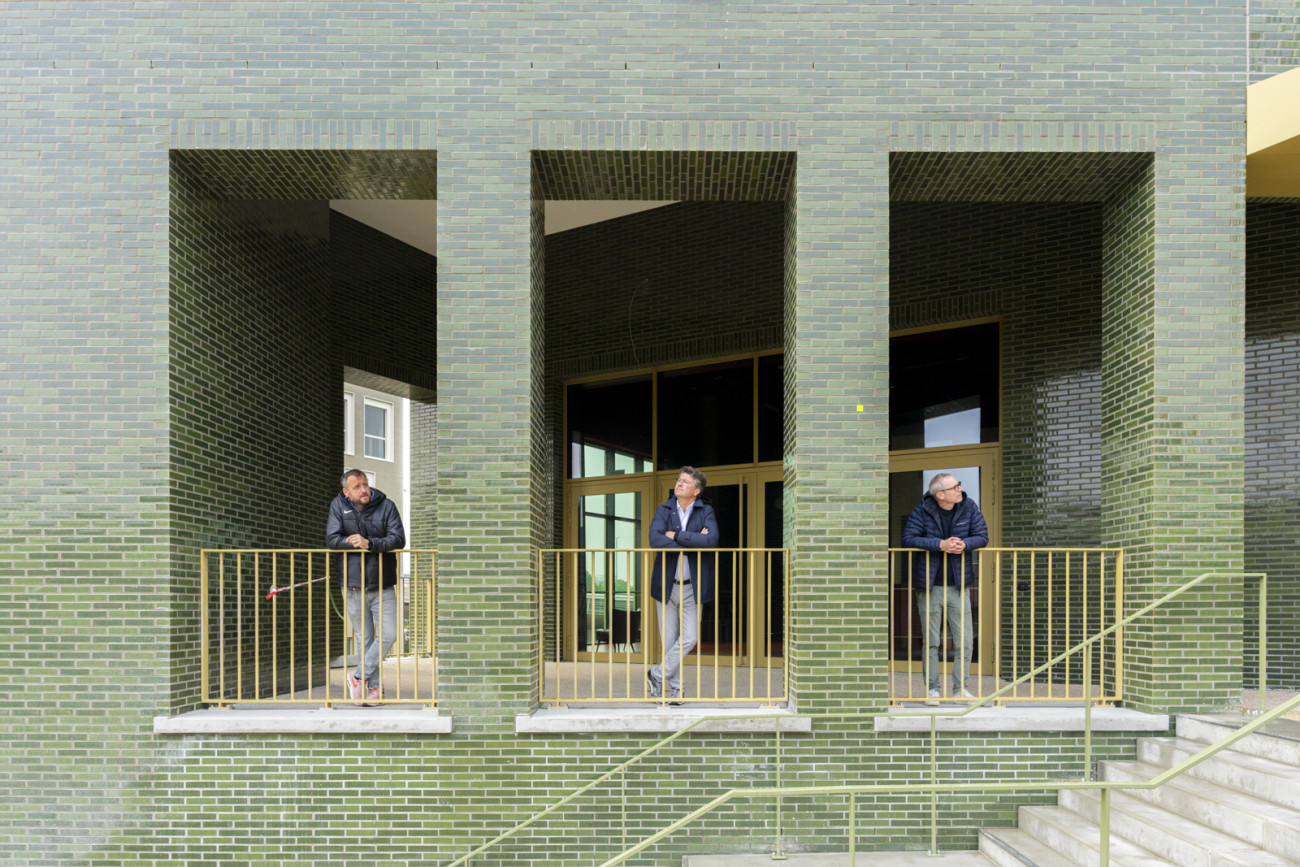
For the realization of Upoffiz | Upliving Ghent - Loop5, Upgrade Estate collaborated with architectural firm Bontinck and garden and landscape architecture firm Basta. That it was a constructive collaboration is shown by the result. How it all went, we asked them ourselves.
Can you briefly explain what your company stands for and what typifies you as a designer?
KENNY: BASTA is a garden and landscape architecture firm that employs 8 people. We work on different scales, from very small to very large, with little budget to big budget, as long as the demand is nice. The diversity of assignments is great and I like that as a person myself. What typifies our agency is a kind of orderly nonchalance. We work thoughtfully, but exude a cozy and informal look and feel. For us, though, green is the most important element with which we try to create fun and livable spaces.
JOHN: Bontinck Architecture & Engineering is an architectural firm that employs about 30 people. We like to kick against sacred cows now and then. Here, for example, but also at the Ghelamco Arena, for example. This is not just about architecture, but also about helping to shape the program of requirements. We really enjoy doing that. In three years, we'll exist a hundred years from now, and during that century we've done almost everything except a prison. From airport to soccer stadium, from hospital to lots of residential and restoration projects, offices and student housing. It keeps us on our toes to not just deal with residential projects on a daily basis. Today we are thinking about a data center as part of the whole AI story. That's another totally new world.
What is the common thread in that great diversity of destinations?
JOHN: Questioning the program of requirements. How do you deal with that? We always try to look at it with fresh, young eyes, asking ourselves how we would deal with it as young people in their twenties who just graduated. That takes energy, but it keeps us from getting bogged down.
Remember Nele and Koenraad's very first pitch about their plans at The Loop in early 2018? What feeling did you come out of this meeting with?
KENNY: We had known Nele, Koenraad and Upgrade Estate for about 7 years. What I liked was their attitude. “From a commercial standpoint, we don't have to make that outdoor space fantastic to sell our product, but we want it,” they said. I love that because it illustrates the type of builder you are dealing with. They are people who want to develop quality space and outdoor space from the heart. Reflecting on their previous projects, they felt that that outdoor space needed an extra boost and for that they wanted to provide energy and financial resources. We are talking about four buildings with outdoor space within a difficult context. I liked that, also to do it with Bontinck.
Een van de belangrijkste krachten van het project voor mij is dat we redelijk snel samen aan tafel hebben kunnen zitten. Er ontstond spontaan een soort yin-yang evenwicht tussen ons, maar ook tussen de opdrachten. Een tweede sterk element vind ik de compositie van de gebouwen. Als je hier rondloopt, krijg je het gevoel dat alles fantastisch is verankerd in zijn omgeving. Je krijgt het gevoel dat je op een campus staat die ruimer aanvoelt dan de grenzen van het terrein zelf. Je hebt doorkijk en luchtigheid die de architecten mee hebben gecreëerd door bijvoorbeeld de neuzen van de gebouwen te plooien zodat er interactie ontstaat met de gebouwen erachter. Die spanning vind ik heel prettig, samen met een soort rustgevend gevoel dat je ervaart in een harde omgeving. Voor mij zijn dat de topkwaliteiten van het project.
JOHN: Er is daar van bij het begin veel over gediscussieerd en hard op gewerkt met het team van opdrachtgever, architect, landschapsarchitect en andere partijen. Ik denk dat we daar het project hebben gewonnen.
GUNNAR: Van veel projecten herinner ik me niet zo goed het begin, maar bij dit project komt me dat wel scherp voor de geest. We zijn er snel ingevlogen en van meet af aan was duidelijk dat het geen kantoorgebouw mocht zijn. We zaten wekelijks met Koenraad en Nele samen rond de tafel om dat basisconcept van in het begin zo scherp mogelijk te krijgen. De intensiteit was meteen heel hoog.
The design process took 2 years. You were at the design table together from the beginning. How unique is this?
JOHN: With every project there is that moment of ça passe ou ça casse. I remember perfectly that moment in our office with Koenraad and Nele where we had example A with a more classical orthogonal story and example B that started from the idea of a honeycomb structure. We started designing on the latter which led us to very atypical shapes. You decide to go for it and that's always a leap. Yet we did and I'm still enormously grateful for that. None of the top 10 biggest Belgian developers would have followed that, none, I'm almost sure.
It is an atypical design because it does not follow some common things in terms of proportions for typical offices. Yet in terms of tenant, it attracts both a classic big five company and an innovative knowledge company. It is the ideal builder to create such an island in an aggressive environment, almost an oasis with buildings, among 't greenery of course. That invites to pour such an atmosphere here via further developments into a follow-up story.
GUNNAR: There is a lot of interaction between the buildings on the site itself, but also with the context. I think that's the magical thing about this project. When you drive on The Loop, you're stuck in a loop. When you walk around here on that green deck, you just see the green areas that you wouldn't see otherwise. You float somewhere above that banal infrastructure and harsh reality. You look between everything and get different views than if you were in a classic orthogonal building structure, where you look between two buildings with perpendicular walls.
KENNY:What I like about this builder is that they really want to take pride in their work, and that transcends the Excel table. With many developers, it's about selling as much as possible, make a profit and we're gone. Nele and Koenraad want quality, doing what they think is good and fun, and so they transcend numbers. I think that's a big difference.
During preliminary discussions with city departments, there was a lot of skepticism about the green deck. What was the reason for that, Kenny?
KENNY: I know of very few projects where I can put between 60 cm and a meter of substrate on the deck. That means your piles have to be sturdier, you have to excavate differently and the build-up is much more expensive. You have to duplicate everything. With many developers, it's fighting to go 10 inches deeper. Nele and Koenraad start from quality. If that requires so much substrate, we do it. As designers, we prefer to work in open ground. That makes sense. Trees and plants don't naturally grow on a roof. Full ground is always better. There is vigilance among city and green departments about the quality of green structures on rooftops because it is often greenwashing. On the site here, we have used sufficient substrates and applied enough techniques. The trees here can continue to root under the pavement because we have also provided substrates there. The water balance is right, the packages are right and our type of planting is adapted to the technical structure.
We know in advance that the planted trees that normally reach 20 meters will reach 9 to 12 meters here. For us, that's good because we're aiming for a layering of greenery, the scale will sit right. The green service says those trees will never reach 15 or 30 meters in height. That's true, but for me they don't have to. If only a third dimension of greenery is created, trees should not have their full maturity as they do in full nature. You have that debate, but I don't think we should be too radical with greenery. Come back here in 3 to 5 years and that's a green oasis here.
To obtain that connection, we then ended up with the grid of a honeycomb with those specific angles.
- Gunnar
The result is great! John, how did you come up with the idea of the challenging shapes of the buildings?
JOHN: There are always different influences during a design phase. Again, our client quickly gave direction to the story through humanity and integration of nature as core elements. Kenny got involved right away. So from the beginning we knew that we were not going to follow orthogonal structures, but rather start from the structure of a honeycomb structure.
GUNNAR: Very important in the beginning of this design story has also been language. Connect was a very distinct word from Nele in the beginning. Then the question is how do you make something that connects different pavilions where you still have to realize a fairly heavy program in a limited space. In order to get that connection we ended up with the grid of a honeycomb with those specific corners. You immediately have many more sides that can work with each other and thus more potential to work with connections. That also affects the intermediate zones and the way the light falls. That combined with the green story makes for interesting perspectives and views.
How did you experience working with the Upgrade Estate construction team?
JOHN: It wasn't always easy. Within a project on that scale, you have moments when some people don't see it anymore, don't have a grip. We fortunately found a certain peace that allowed us to get through the more difficult moments.
GUNNAR: You shouldn't forget that during the permit period we were in full corona period. Shortly thereafter, the Ukraine issue caused the price of gas to skyrocket, resulting in an energy crisis. The price of the glazed bricks you see here on the exterior walls tripled at one point.
JOHN:Ultimately, you have to have faith in how that process will eventually land. I've experienced that in other projects as well. Those are the great projects. If you're lucky enough to be 75 to 80 years old, that's still one of the files you're proud to have participated in.
KENNY: As landscape architects, we have a less difficult job than architects. If a tile sinks, so to speak, we replace it. If a building collapses, that's problematic. Our job is easier in that respect, so probably a little less stressful. I know the system of Upgrade Estate. The pace that has to be in it, the deadlines and the fact that they also want to take over things. I have no problems with that because it always leads to a good end result.
For Nele, connecting was crucial: the challenge was to connect several pavilions with little space.
- Gunnar
The outdoor experience is unseen! A slide, trampolines, meeting pods and an auditorium among the greenery: how many times have you been able to realize such a design Kenny?
KENNY: We certainly don't come across that very often. Most projects end up at a certain standard level. Here we were able to exceed that standard. Trampolines, a slide, those are gadgets in themselves. I do find it laughable that someone goes down a slide from his office. I think that's fun, but to me those are not elements that make or break the project. Those are on a different scale. But if those are desired and they make a smile appear, I do like that.
On a scale of 1 to 10, how proud are you of the result?
JOHN: Great distinction. Then that's 8 out of 10, 8.5? I do feel proud and proud and especially very curious Kenny what that's going to be here in 5 years, because then the relationship between that greenery and the buildings will be much more apparent. We have enjoyed ourselves here and we are very satisfied.
KENNY: It's still hard for me to distance myself sometimes because just a month ago this place was full of excavators and half scaffolding. Now you are only beginning to see how everything is falling into its folds. It's the same with the green area too. A month ago it was all earth. Once that's all overgrown, I think we're going to see a beautiful result here.
KENNY: I'm never really proud. You have the process going, you're done and actually I feel like doing something new again. We had a great time here and we are very satisfied. When I came in here just now and the lady at the front desk answers me when I ask how it is here that it is especially nice working here, both for her and for her colleagues. I think that's super important. That's why you do it, that's what it's all about.
We enjoyed ourselves here and we are very satisfied.
- Kenny
